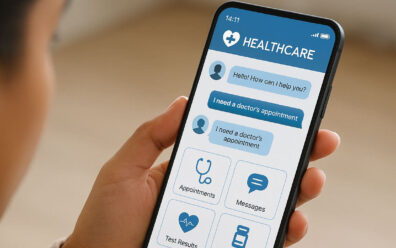Contact-Center Outsourcing6 Minute Read
What Makes a Successful On-Demand Business Model for Customer Care?
Running a successful business has become a complex undertaking, regardless of industry. Not only do you have to deliver your product or service better than any of your competitors, but to truly rise above the pack, you also have to enlist the expertise of a series of specialists—in finance, technology, human relations, communications, and of course, customer service. Because of this need for specialized assistance in customer care, many companies are turning to outsourced contact center providers to help them deliver a great customer experience — a trend that has not gone unnoticed and has led to an abundance of customer service providers, some qualified, others not, entering the on-demand marketplace. That means that choosing a partner in customer care has become a complicated task for leaders and managers. Here are some tips and questions that will help you vet any potential partnership with a customer service outsourcer.

A successful on-demand business model for customer care typically includes but is not limited to the following elements:
- Rapid Response Times: Customers expect immediate assistance, so it’s important to have a system in place to quickly respond to inquiries and resolve issues.
- Personalization: Customers want personalized attention and service, so it’s important to gather information about customers and use it to tailor interactions.
- Convenience: Self-service interactions should be easy for customers to use, with clear instructions and a simple process for requesting assistance.
- Flexibility: Customers may have different needs and preferences, so it’s important to offer a range of service options and be able to adapt to changing circumstances.
- Reliability: Customers expect consistent, high-quality service, so it’s important to have processes and procedures in place to ensure that service is delivered as promised.
- Communication: Keeping customers informed about the status of their requests, issues, and resolutions is essential for successful customer care.
- Continuous Improvement: Continuously monitoring and improving the service based on customer feedback and metrics is crucial for long-term success.
Rapid Response Times
Rapid response times are a critical aspect of customer care, as customers expect immediate assistance when they have a question or issue. A fast response time helps to create a positive customer experience, builds trust, and can lead to increased customer satisfaction and loyalty.
To achieve rapid response times, companies should have a system in place to quickly triage and route incoming customer inquiries to the appropriate team or agent. This could include using an automated system, such as a chatbot, to handle simple questions and issues, and routing more complex inquiries to human agents.
Another important aspect of rapid response times is having a sufficient number of agents available to handle customer inquiries. This can be achieved through a variety of strategies, such as having a large pool of agents on call, using remote agents, or using AI-based solutions to automate certain tasks.
Additionally, it’s important to have clear and efficient processes in place for addressing customer issues. This could include having a knowledge base or FAQs readily available and providing clear instructions for customers to follow when requesting assistance.
Finally, companies should continually monitor and measure response times, and use this data to identify and address any bottlenecks in the process. This will help to ensure that response times remain fast, even during periods of high customer demand.
Personalization
Personalization in customer care refers to the process of using information about a customer to tailor interactions and provide personalized service. This can be achieved by gathering information about customers, such as their preferences, history, and behavior, and using this information to inform interactions with them.
There are several ways to gather information and other valuable data about customers, such as:
- Surveys and Feedback: Asking customers for their opinion and feedback can provide valuable information about their needs and preferences.
- Social Media: Companies can also gather information about customers from social media platforms, such as their interests, demographics, and purchasing history.
- Data from Customer Interactions: By keeping track of customers’ interactions with the company, such as their purchase history, support tickets, and call logs, companies can build a detailed picture of each customer’s needs and preferences.
Once this information is gathered, it can be used to personalize interactions with customers in a number of ways. For example, by providing personalized recommendations based on a customer’s purchase history, or by addressing customers by name when interacting with them.
Convenience
Convenience is an important aspect of customer care, as customers expect to be able to easily and quickly get the assistance they need. A convenient on-demand customer care model should be easy for customers to use, with clear instructions and a simple process for requesting assistance.
Here are a few ways to make customer care more convenient for customers:
- Multi-Channel Support: Customers should be able to request assistance through a variety of channels, such as email, phone, chat, and social media, and receive consistent service no matter which channel they choose.
- Self-Service Options: Companies should provide customers with access to self-service options, such as a knowledge base, FAQs, and online tutorials. This can help customers quickly find the information they need without having to contact customer support.
- Simplified Processes: The process for requesting assistance should be as simple as possible, with clear instructions and minimal steps required. This can be achieved through the use of automated systems, such as chatbots, and simplifying the process for customers to request assistance.
- Mobile-Friendly: With the majority of people using smartphones, it is important that customer support is mobile-friendly and easily accessible via mobile devices.
- Proactive Assistance: Companies can proactively reach out to customers to offer assistance or address any issues they may be experiencing before they have to request it. This shows customers that the company is actively working to provide a positive customer experience.
By making customer care more convenient, companies can improve customer satisfaction and build trust with their customers, which ultimately leads to increased customer loyalty and retention.
Flexibility
Flexibility in customer care refers to the ability of a company to adapt to different customer needs and preferences. This is important because not all customers have the same needs or preferences, and a one-size-fits-all approach may not be effective in meeting their needs.
Here are a five ways to provide flexible customer care. Although similar to some mentioned above:
- Customizable Service Options: Companies should offer a range of service options to customers, such as different levels of support, and allow customers to choose the option that best meets their needs.
- Adaptability: Companies should be able to adapt to changes in customer needs and preferences, and be able to adjust their service offering accordingly. This could include adjusting service hours, offering new service options, or implementing new technologies to improve the customer experience.
- Language Support: Companies should provide support in different languages, to accommodate customers who may not speak the primary language of the company.
- Flexible Scheduling: Companies should offer flexible scheduling options to customers, such as the ability to schedule appointments or support sessions at a time that is convenient for them.
- Special Needs: Companies should be able to accommodate customers with special needs, such as those with disabilities or those with certain cultural requirements.
Flexibility in customer care is important because it helps to ensure that customers are able to get the service they need when they need it and in a way that meets their preferences. This can improve customer satisfaction and lead to increased customer loyalty.
Reliability
Reliability in customer care refers to the consistency and dependability of the service provided to customers. It means that customers can trust that they will receive the same level of service each time they interact with a company and that their concerns will be addressed in a timely and satisfactory manner.
A company that is reliable in customer care will have processes in place to ensure that customer inquiries and complaints are handled efficiently and that any issues are resolved quickly. They will also have a team of well-trained and knowledgeable customer service representatives who are able to provide accurate and helpful information to customers.
Having a reliable customer care department can help to build trust and loyalty among customers, as they will feel confident that their needs will be met. This can lead to increased customer satisfaction, repeat business, and positive word-of-mouth recommendations for the company.
Communication
Effective communication is a key aspect of customer care. It involves the ability of customer service representatives to clearly and effectively communicate with customers to understand their needs and concerns, provide accurate information, and resolve any issues that may arise.
Effective communication in customer care can take many forms, including verbal, written, and nonverbal communication. Verbal communication includes face-to-face interactions, phone conversations, and online chats. Written communication includes email correspondence and written responses to customer inquiries. Nonverbal communication includes body language, tone of voice, and other nonverbal cues that can convey meaning.
Good communication skills are important for customer service representatives as it allows them to establish trust and build rapport with customers. It also helps them to better understand the customer’s needs, concerns, and expectations and tailor their responses accordingly.
Effective communication in customer care also requires active listening, empathy, and the ability to communicate in a clear, concise, and professional manner. Additionally, it requires the ability to handle difficult or angry customers in a calm and composed manner and knowing when to escalate a situation to a supervisor or manager if necessary.
In today’s digital age, companies also have to be able to communicate effectively through various digital channels such as social media, live chat, and messaging apps. This way customers can reach out to them in the most convenient way for them.
Continuous Improvement
Continuous improvement in customer care refers to a process of continuously evaluating and improving the service provided to customers in order to meet or exceed their expectations.
This can involve a variety of activities, such as regularly gathering customer feedback, analyzing data on customer interactions, and monitoring key performance indicators (KPIs) such as customer satisfaction and resolution time.
Based on this information, companies can identify areas for improvement and implement changes to their processes, training, and resources to provide better service to customers.
One example of continuous improvement in customer care can be setting up a customer feedback system. This can involve regularly surveying customers to gather their feedback on the service they received, and using this information to identify areas where the company can improve.
Another example can be to monitor the performance of the customer service team by looking at metrics such as first contact resolution rate, call handling time, and customer satisfaction scores. This data can help identify areas where the team is performing well, as well as areas where training or other interventions may be needed to improve performance.
Continuous improvement in customer care can lead to increased customer satisfaction, loyalty, and repeat business, as well as improved efficiency and cost savings for the company. Additionally, it can help a company to stay ahead of the competition by constantly adapting and improving to meet the changing needs and expectations of customers.
3 Questions to Determine the Quality of an On-demand Customer Care Business Model
Question #1: To What Extent Does Technology Factor into Your Customer Service Delivery?
Any effective, on-demand business model for customer care should include a strong emphasis on technology. This, however, is something of a trick question, since technology, as important as it is, isn’t the absolute most important factor here. An emphasis on anticipating and meeting the needs and preferences of the customers, as well as the expertise and experience to actually pull that off, is the real driver of quality, and the true area of focus for a successful on-demand customer service provider.
All the same, it takes a strong technological basis to pull off this important task. Meeting customers where they congregate means not only possessing the expertise to know where that is but also the technological capability to be able to offer a great experience to customers who find you there. And this includes the gamut of today’s customer communications channels, including:
- Website interactions, such as driving online sales via your website, and communicating via chatbot to visitors.
- Third-party transactions, including sales via Amazon, eBay, and other online retailers.
- Social media communications via Facebook, Twitter, Instagram, or wherever your particular customer base prefers to hang out.
- Email marketing delivers specialized messages to sales prospects, as well as select segments of your existing customers to drive loyalty.
- Phone calls may seem like an old-school method of communication, yet today largely relies on technology like Voice-Over Internet Protocol (VOIP), in which phone services are delivered via the internet.
Delivering the best possible customer experience in each of these channels means not just maintaining the up-to-date best practices for each, but also the physical hardware needed to ensure smooth operations and continuous uptime. That includes continuous upgrades to software, security patches, the latest hardware, and up-to-date training to ensure that personnel can skillfully use it all.
The bottom line? An on-demand business model shouldn’t take the view that technology is the most important factor of customer care, but it should still possess strong technical expertise and the means to provide consumers with access to information via the channel they prefer. Having access to an on-demand business model means providing consumers with access to information via the channel they prefer.
Question #2. How Would You Describe Your Network of Customer Care Agents?
The answer you’re looking for here includes the words “versatile” and “distributed.” To deliver world-class customer service that’s truly flexible enough to meet the needs of any company in any industry, it’s essential for an on-demand business model to include access to a vast network of skilled customer care agents spread throughout the country.
The importance of a diversified level of expertise that includes agents well-versed in a variety of specialties may be obvious. But why is geographical distribution equally essential? If a natural disaster should strike in your part of the country—an increasingly common phenomenon across the U.S.—your customer care provider should be able to instantly provide agents from another region to ensure business continuity. And that requires a large enough network for agents to be readily available, at any given time.
Furthermore, it’s also important that your partner takes steps to ensure this network of agents is not only available but operating at the top of their game. That means an emphasis on a great culture for those agents, even if they work in a virtual environment (as many of today’s best agents do). It also means providing sophisticated and effective options for ongoing education to make sure they’re constantly performing at the top of their game.
Question #3. Can You Describe an Instance Where Your Business Model Helped a Client Achieve an Important Goal?
Any on-demand business model worth its salt should be able to demonstrate specific value with examples of when it’s accomplished a high-stakes goal for a client under pressure. And that doesn’t just mean meeting the challenges of day-to-day operations. It also involves the ability to leverage exceptional resources and expertise to deliver solutions in extraordinary situations.
Case in point: When faced with the challenge of rolling out an ambitious new Medicare-related enrollment program in a limited timeframe, a FORTUNE 100 healthcare services turned to Working Solutions to provide a team of multi-language healthcare specialists who could answer complex questions of a medical nature (while complying with the medical industry’s stringent HIPAA guidelines).
This challenge was as dramatic as it was unanticipated. With its existing call center facilities already operating at full capacity, the client faced a real crisis that compromised the loyalty and satisfaction of its members. Additionally, time was a factor, as were financial constraints.
As a longstanding partner for on-demand customer solutions, we were able to support the client by offering access to 150 bilingual nurses within three weeks of the client’s request. These were specialized professionals who knew enough about the type of care needed to get to work after only one day of core training.
This successful outcome not only met the client’s immediate needs—managing spikes in call volume across each of its programs while containing associated costs and maintaining the highest quality of care—it also provided a foundation for future growth by offering a sample of what an expanded customer experience would entail for that particular company, and how it could be accomplished.
Finding the Right Partner
No two on-demand business models are exactly the same. Particularly among the leaders in the contact center industry, there will be different approaches to each aspect of the customer experience. But you can still go a long way toward determining the value of any potential partner by how they answer these three basic questions about their business model for customer service.
If you’re interested in learning more about how our on-demand business model for customer care can help you meet your goals (and achieve new ones), we’re standing by to answer these three questions—and any others you may have.
Contact us here to schedule your complimentary consultation with a Working Solutions expert.
Let's connect
This Might Interest You...
This website uses cookies to personalize and improve your experience. Continue browsing our site if you agree to our Cookie Policy or feel free to Manage Cookies yourself.


